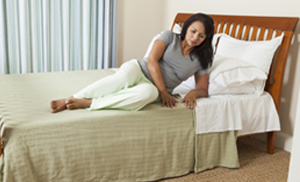Good posture protects your back when you sit, stand, and walk. It is also important while getting into and out of bed. Follow the steps below to get out of bed. Reverse them to get into bed.
Safety tip
Sit at the side of the bed for a few seconds before standing up. Then, after you stand up, wait a moment before walking to be sure you’re not dizzy.
1. Roll onto your side
-
Keep your knees together.
-
Tighten your stomach muscles to keep your back from arching.
-
Put your hands on the bed in front of you.
2. Raise your body
-
Push your upper body off the bed as you swing your legs to the floor.
-
Keeping your back straight, move your whole body as one unit. Don’t bend or twist at the waist.
-
Let the weight of your legs help you move.
3. Stand up
-
Lean forward from your hip and roll onto the balls of your feet.
-
Tighten your stomach muscles to keep your back from arching.
-
Using your arm and leg muscles, push yourself to a standing position.



